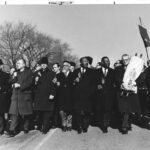Reverend Jamie Washam, PhD
Protest can be a form of prayer, heard both in the rhythm of the psalms and soles on pavement.

First Baptist Church in America
Providence, Rhode Island
An American Baptist Perspective
Where did you first encounter Heschel’s work?
As a student in divinity school.
How did Heschel and his thinking inspire your work, religious life, or civic engagement?
In the late 1990s, the Rev. Dr. Vincent Harding offered a course on Beloved Community at Harvard Divinity School. He taught about how Rabbi Abraham Joshua Heschel marched alongside the Rev. Dr. Martin Luther King, Jr., and others in the struggle for civil rights. The idea of praying with our legs and feet opened my concepts of embodied faith. Petitions for justice and peace take root in deep intercession and thrive in community. Heschel’s embrace of active service as a complementary mode of prayer expanded my theology and practice. Alongside faith, he urged leaps of action towards the righteous world we desire to inhabit. Protest can be a form of prayer, heard both in the rhythm of the psalms and soles on pavement.
Decades later, I heard Heschel’s call put to music by Paul Vasile, in his song, “Pray with Our Feet.” May the teachings of this good rabbi continue to inspire action and awe for generations.
It’s not enough to offer thoughts and prayers.
Paul M. Vasile, LovedIntoBeing Music ©2018
It’s not enough to say that we care.
It’s not enough to hope that things will change.
We’ve got to pray with our feet,
pray with our feet, pray with our feet
and get out, out on the street.


